We always prefer the best of all, when it comes to our infants. The infants are fed with only breast milk until the age of 6 months. Once the baby starts to grow it requires more nutrition in the food. Only breast milk is not enough for the baby. And the baby tends to lose the fat content of the breast milk after a certain time.
So you end up wondering, what is the best nutritious food you can give your child? Here are a few essential elements that you have to know, on why you should give ghee to your infant, baby.
You will also have various questions in your mind regarding- the best ghee for babies. When to introduce ghee for babies? Is ghee safer for your babies? Or what are the benefits of ghee for kids?
Giving the best ghee to babies can be the main food supplement. Best ghee for babies can be bought at our online store https://sureshfoods.com.
What is Ghee?
Ghee is a type of clarified butter that possesses high nutritional values. Cow ghee has many benefits as it is rich in vitamin A2, E, and D with Omega3 properties. The essential elements present in ghee help your baby’s growth and development.
Why To Include Ghee In Your Baby’s Diet?
Though there are many reasons why to add ghee to our everyday diet, here are a few vital reasons for including a moderate amount of ghee in your baby’s daily diet.
- A growing baby needs almost 1500 calories per day for optimum growth and physical and mental development. Including Ghee in your baby’s daily diet is an easy way to boost his calorie intake and keep him active.
- Studies show that 30 to 35 per cent of calories that a baby need came from FAT. But be wise to feed him with correct fat, not just fried food. Use ghee in daliya, khichari, roti, dal, vegetables etc.
- After you stop breastfeeding your baby may subsequently start losing weight. It is because the fat intake of your baby is not sufficient after you stop breastfeeding. To control fat deficiency, introduce ghee in the baby’s diet to maintain fat intake per day.
- ‘Ghee’ is a healthy source of fat and contains the all-important Docosahexaenoic Acid (DHA). DHA has been deemed necessary for brain development and growth.
- Ghee is also renowned for its anti-fungal, anti-oxidant, anti-bacterial, and anti-viral properties which can boost eyesight, immunity, digestion and help your baby achieve optimal growth.
Health Benefits of Desi Ghee for Kids:
- Easy to Digest: Ghee is full of saturated fatty acids, and they are easily digestible. Kids are unable to digest other fatty foods. Ghee is one of the simplified fat food, which can enhance calorie intake and keep energetic.
- Lactose Friendly: Ghee is a dairy-based product and you can break down lactose sugar during the clarification process. Even if your baby is lactose intolerant, he can consume ghee.
- Rich in Vitamins: Ghee is a rich source of fat-soluble vitamins like Vitamin A, D E and K. All these vital vitamins help promote the healthy bone and brain development of your baby. Additionally, these vitamins also boost your baby’s immune system and keep free from diseases.

Buy cow Ghee Online: Order Now. Free Shipping
When can I give ghee to my baby?
Cow ghee is given to the infants at the age of 6 months by adding a few drops of ghee in the baby’s lentil or mashed rice etc. Best ghee for babies helps in brain development and keeps the child healthy. Other than nutrients, carbohydrates and proteins, fat is also required for the better development and overall growth of the baby. As cow ghee for infants is a healthy fat, it provides the baby with calories to stay active and energetic all day. It has a specific amount of Vitamin A, E and D. Omega-3s and Omega-9 which is monounsaturated fats, Conjugated Linoleic Acid (CLA) and butyric acid are also present in ghee.
How much ghee can I give my baby?
You would have seen grandparents and your aunts suggesting you feed cow ghee for infants after a certain period(usually 6 months). Paediatricians also recommend ghee to be provided to the babies with semi-solid foods like mashed vegetables, dal, idli and rice etc (after they attain 6 months).
Many have this misconception that ghee gives the same nutritional benefit as butter. Butter is made by churning milk or cream. It contains lactose and casein which may cause digestive issues. This table gives you an overview of the approximate quantity of cow ghee for infants to be given, based on their age:
| Age ( months/year) | Quantity |
| 6-10 months | Few drops to 1 tbsp |
| 12-24 months | 1 tbsp to 1 1/2 tbsp |
| 2 years and more | 2 tbsp (also depending upon how your child prefers having it.) |
An excess of ghee can be harmful to your growing baby. Hence, you should keep a close eye on the quantity of ghee consumed by your baby. Please consult your doctor, for recommended quantity, before introducing Ghee in your baby’s diet.
Easy homemade ghee recipe for babies
Kids want a variety of tastes in food. Try adding a new flavour to the food variety or adding some veggies or fruits to increase weight gain for babies. Granny used to make ghee religiously with the malai (milk cream) collected during the week, in my childhood days. The aroma of fresh ghee used to float around our house till evening.
Ghee is often given to babies over the age of 6 months. In many parts of India, there’s a custom requiring every spoon of baby food to be enriched with ghee. While homemade ghee has its immense benefits, it has to be employed in moderation as large quantities can have adverse health effects.
Two recipes using desi ghee to weight gain for babies
1.Veggie puree with ghee-
Ingredients:
- Potato-1 medium-sized
- Peas- ½ cup
- Beans- ½ cup
- Ghee- 1 tsp
Directions:
- Chop the beans into small pieces after washing.
- First, peel the skin of the potato and dice the potato into small parts.
- Take a saucepan, boil 2 cups of water and add all these veggies.
- Shell the peas from the pod.
- Make the puree of cooked veggies, while turning off the gas make sure softness of veggies.
- Once the dish gets cooled, add ghee as a topping to the puree and serve it. baby’s weight gain dish is ready.
2. Sooji kheer-
Ingredients:
- Milk- 3 cups
- Sooji- ½ cup
- Jaggery- 1 tsp
- Ghee- 1 tsp
Directions:
- Heat some ghee and fry sooji till it turns golden brown.
- Add milk and stir it to allow the milk to boil on a low flame.
- Once the milk gets boiled, add jaggery and add sooji, keep stirring it to avoid the lumps until the sooji gets cooked.
- The sooji kheer is ready to eat.
Massaging your baby with Desi Cow Ghee
In India, we see that grandparents will start giving an oil massage before a bath. Usually, they use ghee or coconut oil or mustard oil which is available at home. As massage is considered, it is the best way to express love and care to the infant. Mostly, desi ghee is suggested due to its Ayurvedic property.
Many mothers have trusted Suresh Desi ghee and have also used them for their infants/babies. Now the question is- Where can I buy the best ghee for my baby? You can buy organic ghee at our online store. Visit our website https://sureshfoods.com/ to know more about us.
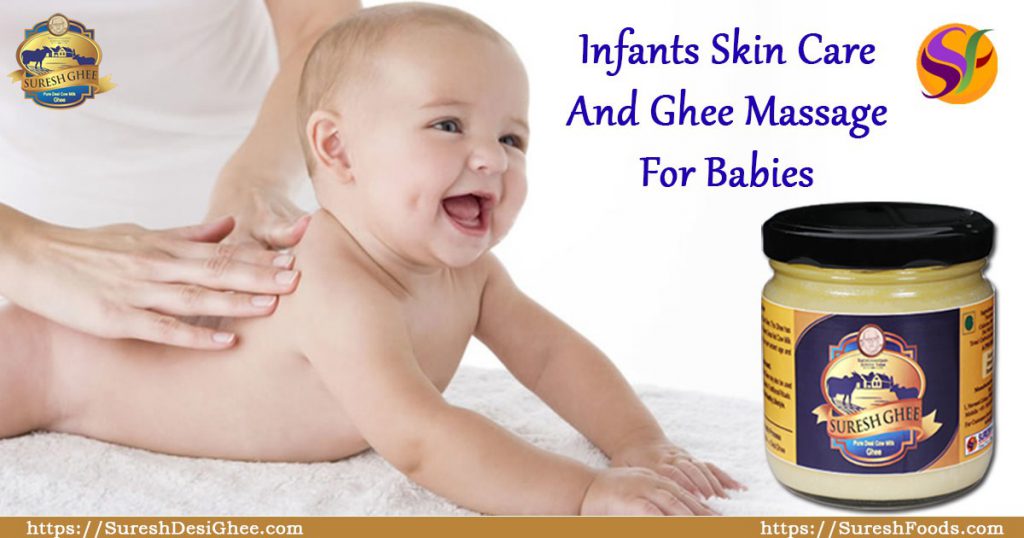
Buy Pure Desi Cow Ghee Online : Order Now. Free Shipping
The benefits of ghee for babies by massage are:
- Improves weight gain of the baby.
- Helps in maintaining a soft and glowing skin
- Keeps the baby’s heart rate steady.
- Improves blood circulation.
- Improves the hand and leg movements of the baby.
- Helps in maintaining a stable brain activity.
- Helps the baby to be calm and less fussy.
- Helps the baby to have a better sleep.
- Massage in the initial days of the infant helps in recovering from jaundice.
- It is also told that the skin of the baby gets fairer day-by-day.
Which Is Better for Babies: Ghee or Butter?
When it comes down to providing solid foods to babies, both ghee and butter can turn out to be an excellent option as part of a well-balanced meal. In certain regions of the world, ghee is one of the primitive foods provided to infants. Ghee, basically clarified butter, is obtained by detaching milk fat from milk solids and water, leading to a product having a richer, nuttier flavor and an extended shelf life.
Ghee obtained from pure desi cow milk, has played a remarkable role in both ceremonial and routine cooking for centuries. One of its main benefits is its high smoke point, reaching 482 degrees Fahrenheit (250 degrees Celsius). This property makes it an amazing alternative for cooking oils that tend to go horrible at high temperatures. Furthermore, ghee improves the flavor of dishes, easily by pouring some melted ghee, you can expand the taste of a wide range of dishes. For instance, in India, the world’s substantial ghee producer, it is an essential ingredient that adds flavor to everything from festive biryani to routine dals and hearty khichdi, a combination of moong dal, rice, and spices roasted in ghee.
However, ghee can be added to a baby’s diet as soon as they have started to consume solid foods, which is mostly around the age of 6 months. It’s necessary to understand that ghee is a dairy product, and dairy is a common cause of allergen. Hence, it’s suggested to exercise caution when providing ghee and further dairy products, such as cow’s milk, which should be provided soon after the baby’s first birthday.
It is important to seek your pediatrician’s advice before giving ghee to your baby. Professional advice is recommended for babies who have had jaundice as newborns. Neonatal jaundice is common in most babies. However, if your little one has had a prolonged episode of the disease, avoid giving fatty foods. A compromised liver finds it difficult to digest fats, which may get accumulated in the liver causing health issues.

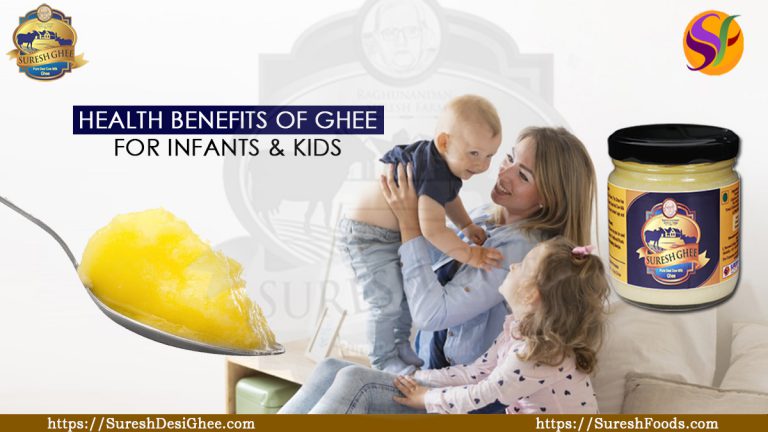


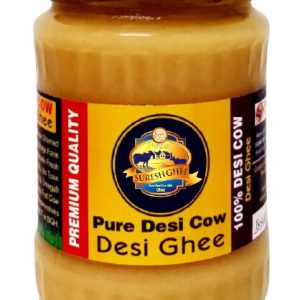
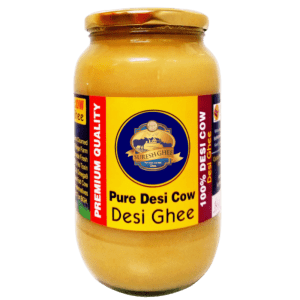
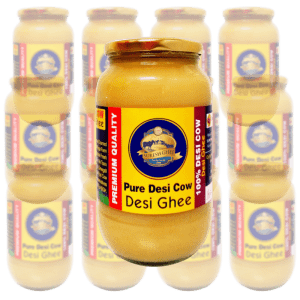
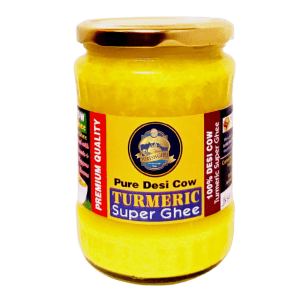
 WhatsApp us
WhatsApp us
Naveen m...